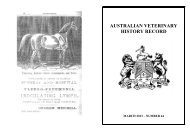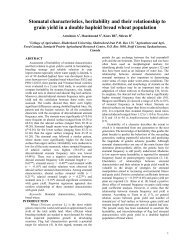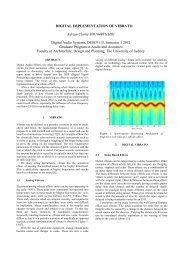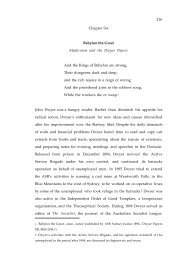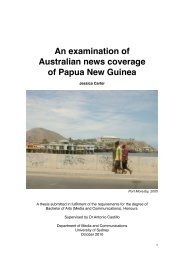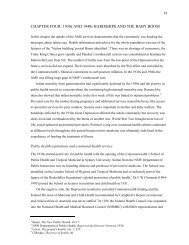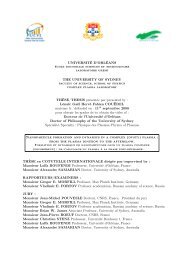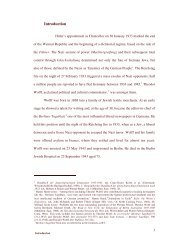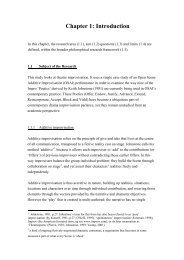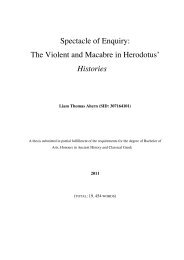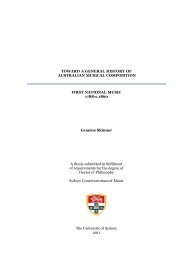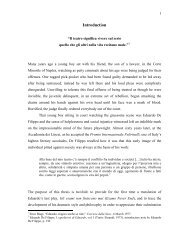Chapter 6: Tense, aspect and mood
Chapter 6: Tense, aspect and mood
Chapter 6: Tense, aspect and mood
You also want an ePaper? Increase the reach of your titles
YUMPU automatically turns print PDFs into web optimized ePapers that Google loves.
are the same as the transitive realis prefix with 2 nd person subject <strong>and</strong> 1 st person object (i.e. you<br />
kiss me). Thus, the following example is ambiguous between an imperative <strong>and</strong> a non-modal<br />
meaning:<br />
(45) Yu-kwa ngayuwa-wa mu-wilyaba.<br />
2/1-give.NP1 1.PRO-ALL VEG-one<br />
‘Give me one (mango(VEG))!’ OR ‘You give me one.’ (Fieldnotes, DL, CW)<br />
The imperative reading is more likely here because of the NP1 unsuffixed stem. Intransitive<br />
hortative prefixes that do not involve third person are also the same as the corresponding realis<br />
prefixes, as shown in (46a). By contrast, the prefixes of transitive hortatives that do not involve<br />
third person are the same as the corresponding irrealis prefixes (46b).<br />
(46) a. Yawa, yi-ngajee-yi-na=dha.<br />
yes 12-fight-RECP-NP2=TRM<br />
‘Yes, let’s fight.’ OR ‘we are fighting’ (‘Seagull <strong>and</strong> Pheasant’ u39-40)<br />
b. Ngayamba-lhangwa yiba-lyang+barri-ya-lhangwa arvngka-manja.<br />
1.PRO-ABL IRR.1/2-head+hit-NP1-ABL NEUT.head-LOC<br />
‘In my turn, let me hit you on the head.’ (‘Seagull <strong>and</strong> Pheasant’ u48)<br />
OR: ‘I will hit you on the head.’ (OR: ‘I have to hit you on the head’; ‘I should hit you on<br />
the head’, <strong>and</strong> so on)<br />
Murrinh-Patha is a language with a similar system of composite <strong>mood</strong> marking, where Past<br />
Irrealis is used in negated past clauses. Past Irrealis is always used in this language in conjunction<br />
with a past imperfective marker (Nordlinger & Caudal 2011), which corresponds to the<br />
Enindhilyakwa fact that the Past Irrealis can only co-occur with P2, <strong>and</strong> not P1. Also in common<br />
with Enindhilyakwa, the Past Irrealis in Murrinh Patha is used outside of negation to express<br />
foreclosed past counterfactuals, comparable to (39) above. Nordlinger & Caudal note that an<br />
interesting consequence of this system is that the same construction is used to encode both<br />
negative past clauses <strong>and</strong> negative past deontic ‘should’ constructions:<br />
(47) Marda the-na-mut-tha palngun.<br />
NEG 2sgS.POKE(19).PSTIRR-3msgIO-give-PIMPERF female<br />
1. ‘You did not give him that girl.’<br />
2. ‘You shouldn’t have given him that girl.’ (Nordlinger & Caudal 2011 ex. 35)<br />
This example is ambiguous between a reading in which the event was not realised in the past (47-<br />
1), <strong>and</strong> one in which it was realised (but shouldn’t have been) (47-2). This ambiguity has not been<br />
tested in Enindhilyakwa. The only example of a negative past deontic ‘should’ construction in my<br />
data is ‘he should not have arrived today’ in (41b). This example involves the evitative clitic<br />
=maka (Appendix M), which may be the reason for the deontic modality. It is however unclear<br />
whether this clitic is obligatory in order to express negative deontic modality. Since the systems of<br />
224



